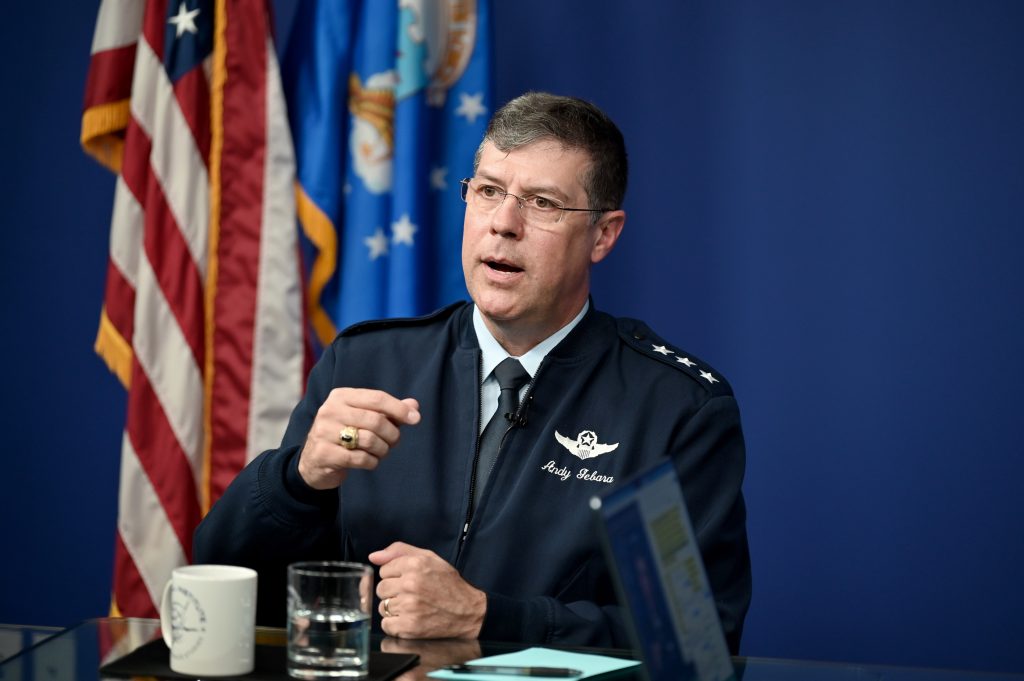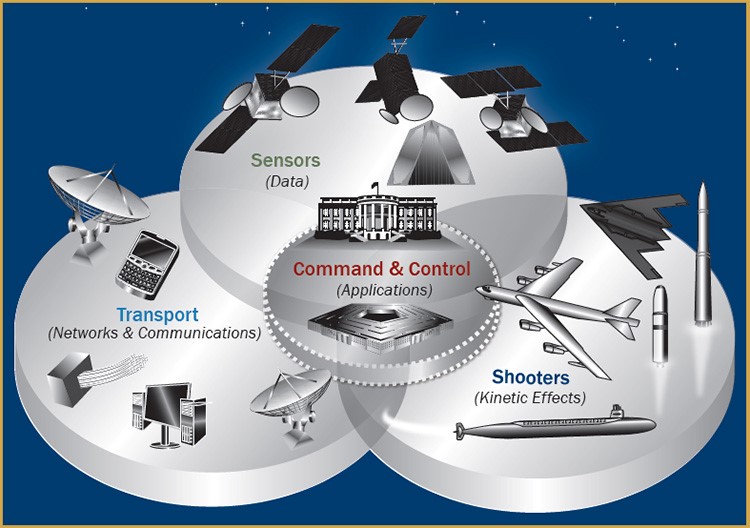The Pentagon’s plans to invest billions of dollars to upgrade and modernize nuclear command, control, and communications can benefit from the work now being done to create a sweeping joint all-domain command and control (JADC2) system linking sensors to shooters in every domain, a top Air Force general said July 15.
Lt. Gen. Andrew J. Gebara, Deputy Chief of Staff for Strategic Deterrence and Nuclear Integration, noted the connection during an AFA Mitchell Institute for Aerospace Studies Aerospace Nation interview. Yet even as analysts agreed, serious questions about how to defend the NC3 network, which some have called the “fourth leg” of the nuclear triad, loom ahead.
“When I was a lieutenant, we would have a completely separate NC3 system from our conventional command and control systems,” Gebara said. “And at the time, we would just put a multibillion dollar satellite up into GEO orbit and then just not think about it anymore because it works pretty well and no one can get after it. That’s not the world we live in today. And so we need to leverage the benefits we’re gaining out of joint all-domain command control.”
Those benefits mean ensuring that if one means of getting a message through fails, another can be found.
Conincidentally, a new report from the Atlantic Council, released the same day, comes to the same conclusion: “The highly integrated nature of modern command, control, communications, and battle management (C3BM) systems necessitates the integration of NC3 capabilities into a broader system-of-systems across the C3BM enterprise,” wrote analysts Peter L. Hays and Sarah Mineiro.
JADC2, often referred to now combined JADC2 (adding a C in front of the acronym) is an ambitious effort to connect sensors and shooters across the globe in different domains, transmitting data at lightning speed to accelerate decision-making.
Similarly, nuclear leaders want to apply that same kind of thinking to new NC3 solutions, potentially leveraging commercial as well as military components to ensure resiliency under attack. According to budget documents, the Air Force plans to invest some $68 million in research and development into “leveraging emerging commercial-based technologies” for NC3.
Gebara noted that NC3 isn’t going to be a single system. “It’s really several hundred nodes that all make up one large system,” he said. “It isn’t one radio that you can just mass produce and give to everybody, because there’s different ways the message has to get through, whether it’s from space, whether it’s terrestrial, whether it’s what have you.”
Yet while JADC2 and NC3 “must be developed in synchronization,” according to Pentagon budget documents, there are clear differences about the needs.
“I think there will always be a human in the loop for nuclear command and control,” Gebara said. “There’s going to be a lot less automation in nuclear command and control than you might see in conventional [JADC2].”

“The modernization of NC3 systems must continue to meet unique requirements for positive and negative control, unlike any other command-and-control system,” Hays and Mineiro wrote. “The recognition of these unique requirements drives special emphasis on understanding deterrence scenarios and objectives, technical capabilities, and potential commercial contributions.”
The Atlantic Council report noted that while JADC2 can emphasize speed and experimentation, NC3 demands a more cautious approach.
Space will play a key role in both efforts—the Space Development Agency’s Transport Layer will be the “backbone” of JADC2, and the Space Force plans to invest billions of dollars on a new NC3 satellite constellation called Evolved Strategic SATCOM to succeed the Advanced Extremely High Frequency (AEHF) satellite constellation.
Given that the Air Force manages both the land and air legs of the nuclear triad and that 75 percent of NC3 systems reside within the Department of the Air Force, the two services must work closely together, Gebara said.
“We’ve been side-by-side, shoulder-to-shoulder for years. I think it’s actually only growing stronger,” Gebara said. “We have reinvigorated what I call the Nuclear Oversight Council. So this is a Secretary of the Air Force-led, co-chaired by the two service chiefs, four-star-level conference that happens three times a year, that is dedicated to the nuclear mission space.”
Hays and Mineiro see risks ahead, both in growing threats in space and Space Force plans for proliferating military satellites in low-Earth orbit. They want greater study of “the nuclear surety implications for the current exploration of disaggregation as a means to ensure resiliency.” The want any satellites supporting NC3 in low-Earth orbit to be hardened against nuclear attack.
Recent revelations that Russia is developing a nuclear weapon for space underscore the risk posed by such weapons. “A high-altitude nuclear detonation (HAND) would raise the peak radiation flux in parts of the Van Allen radiation belts by three to four orders of magnitude,” the Atlantic Council report says. That could “cause the failure in weeks to months of most if not all LEO satellites not specifically hardened against this threat, result in direct financial damages probably approaching $500 billion and over $3 trillion in overall economic impact, and present daunting response challenges, since the attack would be outside of any state’s sovereign territory and not directly kill anyone,” the authors wrote.
The Space Development Agency, which is fielding the proliferated space architecture in LEO, is not planning such nuclear hardening, at least not publicly. SDA Director Derek M. Tournear has said the organization’s satellites will not be hardened against such an attack, but rather only hardening sufficient to ensure operational effectiveness in that orbit. Some of those satellites are meant to be used for missile warning/missile tracking, which could contribute to NC3.
The unique function of nuclear command and control is what makes the stakes so high. “It is absolutely critical that the President has the ability to get a hold of those nuclear forces at all times, in all situations, no matter where he is, what time of day, what time of night, what type of weather, what type of threat,” Gebarra said. “The president of the United States has to be able to talk to a second lieutenant in the missile field in single-digit minutes in order for the system to work.”

